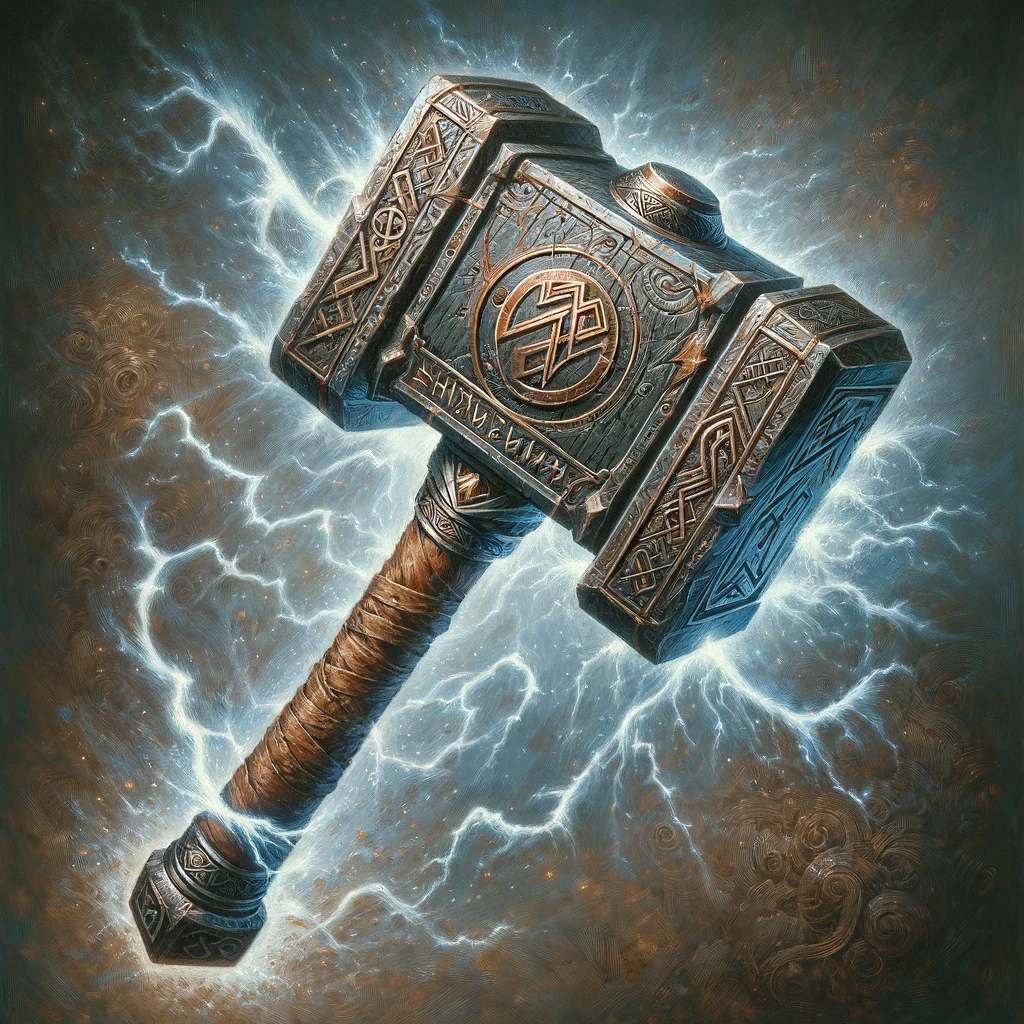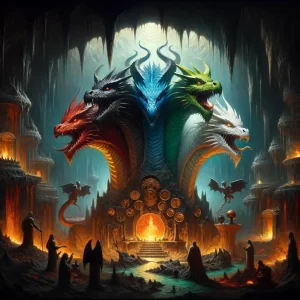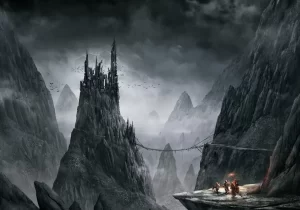"White Plume Mountain" is an iconic D&D adventure, known for its inventive puzzles and traps. Authored by Lawrence Schick, it originally appeared in 1979 and has since become a favorite among players seeking a mix of combat, problem-solving, and exploration. This detailed adventure offers an intriguing blend of narrative depth and challenging gameplay.
"White Plume Mountain" embodies a classical Dungeons & Dragons adventure, engaging players with its creative design and memorable gameplay. Crafted by Lawrence Schick, this adventure has become a seminal experience for those who enjoy a perfect blend of combat, puzzle-solving, and exploration, ever since its original publication in 1979.
The Enigmatic Entrance
The journey begins at the base of the titular mountain, marked by a mysterious plume of white steam. Adventurers must navigate the Wizard's Mouth cave, where a breathing effect created by steam inhalation and exhalation poses the first of many environmental challenges. This entrance sets the tone for the adventure-a blend of natural wonders and magical manipulation.
At the heart of this adventure lies the enigmatic wizard Keraptis, who disappeared into the depths of the mountain over a thousand years ago. The legend of Keraptis serves as a compelling backdrop, enticing adventurers with tales of his magical prowess and the mystical weapons he possessed. This backstory not only enriches the narrative but also deepens the players' engagement as they delve into the mountain's secrets, hoping to uncover lost artifacts and perhaps encounter the legend himself.
Keraptis and the Legendary Weapons
Central to the adventure is the legend of Keraptis, a wizard who vanished into the mountain over a millennium ago. Recent disturbances suggest his return, or at least that someone is using his identity to meddle once more in worldly affairs. The adventurers are drawn into the mountain by the promise of recovering three legendary weapons: Wave, Whelm, and Blackrazor. Each weapon possesses unique magical properties and is guarded by challenging puzzles and foes.
The lore surrounding Keraptis is not just a mere backdrop for the adventure but an integral part of the unfolding drama within White Plume Mountain. As the adventurers probe deeper into the mountain, they encounter various guardians and traps that are said to be remnants of Keraptis's ingenious defensive measures. The legend hints that these weapons were not only forged as instruments of power but also as testaments to Keraptis's arcane mastery and his obsession with immortality.
Each of the legendary weapons-Wave, Whelm, and Blackrazor-carries a history soaked in magic and blood. Wave, a trident rumored to have been forged in the elemental plane of water, offers control over waves and aquatic creatures. Whelm, a powerful warhammer, is particularly effective against giants and is known to emit a thunderous boom when struck. Blackrazor, perhaps the most ominous of the trio, is a sentient greatsword that thrives on the souls of its victims, offering vampiric vitality to its wielder.
The journey to retrieve these weapons involves navigating through a series of meticulously crafted challenges that test both the physical and mental prowess of the adventurers. These challenges are not arbitrary; they are reflections of Keraptis's personality-his cunning, his engineering acumen, and his dark humor. For instance, adventurers must solve a complex riddle presented by a sphinx or risk facing its wrath, and they must strategically navigate a room filled with dangerous geysers that could erupt at any moment.
Moreover, the presence of these weapons in the mountain has attracted various creatures and other interested parties, adding a layer of complexity to the adventurers' quest. The dungeon's current inhabitants, some of whom may be remnants of Keraptis's original creations or minions, are not keen on relinquishing their treasures. This situation necessitates careful negotiation, cunning, or combat, forcing the party to continually adapt their strategy.
The promise of gaining these powerful artifacts is intertwined with the risk of awakening the same forces that drove Keraptis from the world so long ago. Adventurers must weigh their greed for the legendary weapons against the potential reawakening of Keraptis's malevolent will-whether he still lives or has left behind echoes of his magic that continue to manipulate events from beyond the grave. This narrative thread challenges the adventurers to consider the consequences of their quest beyond mere treasure hunting, elevating their journey through White Plume Mountain to an epic saga that tests their very values and purposes.
Magical Items and Artifacts
Unique magical items and artifacts are pivotal to the adventure, notably the three legendary weapons:
Wave: This magical trident is one of the prized artifacts sought in the dungeon. As a weapon of both water and the sea, Wave confers the ability to dominate aquatic creatures and command water in its various forms. Its abilities make it invaluable in combat and exploration, particularly in environments involving water.
Whelm: This warhammer bears the power of thunder and is designed to be particularly effective against giants. Whelm can produce a thunderclap audible for hundreds of feet when struck against a solid object, stunning creatures nearby. Its capabilities are a testament to the deep craftsmanship of dwarves and their affinity with the earth.

Blackrazor: Perhaps the most infamous of the three, Blackrazor is a sentient greatsword that feeds on souls. It grants its wielder the ability to drain the life energies of its victims, transferring their vitality to the user. This powerful, albeit morally ambiguous, ability makes Blackrazor a potent weapon in the hands of those who can control or withstand its influence.
Each of these weapons is not only a tool of immense power but also deeply tied to the lore of the dungeon, representing the apex of magical weapon design by the mysterious wizard Keraptis. Their recovery is the primary goal of the adventurers who brave the traps and puzzles of White Plume Mountain, adding layers of both tactical depth and narrative intrigue to the quest.
Memorable Locations and Encounters
The Riddling Guardian: A gynosphinx challenges adventurers with a riddle at a critical junction. Solving the riddle or overcoming the guardian by force allows further progress.
In "White Plume Mountain," the encounter with the Riddling Guardian serves as a pivotal moment that blends intellectual challenge with potential combat, underscoring the adventure's emphasis on versatility and strategic thinking. The gynosphinx, perched strategically at a three-way intersection within the dungeon, poses a riddle that is both a gatekeeper and a test of the adventurers' wit and wisdom. This riddle, rich in metaphor and history, connects thematically to the broader world of Dungeons & Dragons, offering a deeper narrative experience and a moment of reflection amid the perilous exploration.
The riddle presented by the gynosphinx is designed not only to challenge the adventurers but also to engage them in the lore of the game. It reads: "Round she is, yet flat as a board, Altar of the Lupine Lords, Jewel on black velvet, pearl in the sea, Unchanged but e'erchanging, eternally." The answer, which is "the Moon," ties back to classical and mythical motifs prevalent throughout the D&D universe, enriching the players' immersion in the game's richly woven tapestry.
Should the adventurers solve the riddle correctly, the gynosphinx acknowledges their wisdom by deactivating a magical barrier or simply stepping aside, allowing them to choose their path forward. This interaction highlights the adventure's reward for intelligence and cleverness, traits as valuable as martial prowess in the world of high fantasy.
However, if the adventurers fail to solve the riddle or choose to bypass the intellectual challenge through combat, they face the gynosphinx's formidable strength. This scenario underscores the risks involved in choosing force over intellect, as the gynosphinx is a powerful creature with abilities that can easily overwhelm unprepared adventurers. This dual approach allows for multiple strategies and outcomes, catering to various play styles and party dynamics.
Furthermore, the encounter with the Riddling Guardian adds a layer of moral and ethical decision-making. It poses the question of whether knowledge should be forcefully taken or earned through wisdom and understanding, reflecting the thematic undercurrents of respect for ancient guardians and the secrets they keep. This adds a philosophical depth to the adventure, challenging players not only to think about what they do but also to consider the implications of how they choose to do it.
The Geysers and Chains: Adventurers must traverse a dangerous cavern where geysers erupt periodically, threatening to scald anyone in their path. Navigation involves hopping between suspended disks, requiring both agility and timing.
In the adventure "White Plume Mountain," the Geysers and Chains challenge stands out as a particularly thrilling and hazardous obstacle. Situated deep within the mountain, this cavern is a testament to the volatile power of nature harnessed through arcane means, likely a machination of the enigmatic Keraptis himself. The room is dominated by a large natural cave, across which adventurers must navigate by leaping between a series of suspended disks. These disks, about 4 feet in diameter, are hung from the cavern ceiling by massive steel chains, giving the entire room an industrial yet primordial atmosphere.
The true peril, however, comes from the geysers that sporadically erupt from the cavern floor, spewing scalding hot steam and water high into the air. These eruptions are not only a severe burn hazard but also pose a significant risk of knocking the adventurers from the disks. Each geyser follows a specific timing pattern, which the players must observe and memorize if they hope to cross safely. Successful navigation requires precise timing and keen agility, as adventurers must judge the right moment to leap from one disk to the next while avoiding the powerful jets of boiling water.
This challenge effectively tests both the physical capabilities and the environmental awareness of the party. It emphasizes the need for teamwork, as players might coordinate their movements or aid less agile members across the treacherous path. Moreover, the setting of the cavern, with its roaring geysers and precarious disks, serves to heighten the dramatic tension of the adventure, providing a vivid and memorable gameplay experience.
Additionally, the Geysers and Chains encounter incorporates elements of strategy. For instance, more tactically-minded players might use the environment to their advantage, perhaps luring hostile creatures into the path of the geysers or using the steam as cover. This section of the dungeon, therefore, not only challenges the adventurers' physical prowess but also their ability to think creatively under pressure.
Overall, the Geysers and Chains section is a compelling blend of action and strategy, set in a dynamically dangerous environment that exemplifies the adventurous spirit of "White Plume Mountain." It serves as both a physical barrier and a dramatic set piece that deeply immerses players in the perilous quest for the legendary weapons of Keraptis.
The Spinning Cylinder: A corridor lined with a frictionless surface and a spinning cylinder presents a disorienting challenge that can throw adventurers off balance, literally and figuratively.
In "White Plume Mountain," the Spinning Cylinder is a distinctive and disorienting trap that embodies the adventure's flair for creative and challenging obstacles. This particular section of the dungeon features a long, narrow corridor with a cylinder that spins continuously. The inner surface of the cylinder is coated with a slick, oily substance, increasing the difficulty of maintaining balance and orientation as it rotates.
The cylinder's mechanism is cleverly designed to spin counterclockwise at a considerable speed, creating a dynamic puzzle that requires both physical agility and strategic planning to overcome. Adventurers attempting to cross must deal with the dual challenges of a slippery surface and the disorienting motion, which can easily lead to slips and falls, making progress through the corridor a risky endeavor.
To navigate this trap successfully, players often need to employ creative solutions. Some might choose to crawl to lower their center of gravity and reduce the risk of falling, while others might use ropes or magical aids to secure themselves or their teammates. This encourages teamwork and problem-solving within the group, as they must work together to devise a method that allows everyone to safely traverse the spinning cylinder.
Moreover, the spinning cylinder can serve as a dramatic moment of tension in the narrative, as the risk of injury or worse is palpable. The visual and physical chaos of the spinning cylinder adds a layer of urgency and drama to the dungeon's atmosphere, enhancing the overall excitement of the adventure.
Additionally, this obstacle can be used by the Dungeon Master to introduce elements of timing and precision. For instance, there might be brief moments when the rotation slows or aligns in a way that offers a safer path, requiring keen observation and quick action from the players to take advantage of these fleeting opportunities.
The Spinning Cylinder is not just a test of physical dexterity but also a mental challenge that can be as frustrating as it is thrilling, making it a memorable part of the "White Plume Mountain" experience. It exemplifies the inventive spirit of the dungeon's design, challenging adventurers to think and act swiftly in an ever-changing, dynamic environment.
Traps and Puzzles
White Plume Mountain is renowned for its elaborate traps and mind-bending puzzles that require more than brute strength to overcome. For example:
- The Frictionless Room: A room where the floor is covered in a frictionless substance, making it nearly impossible to walk across without slipping into deadly traps.
- The Floating Stream: An unusual puzzle where adventurers encounter a stream of water suspended in mid-air, posing both a physical and intellectual challenge to navigate.
Environmental Challenges
The mountain itself is an adversary, with its labyrinthine tunnels, steam vents, and the constant threat of boiling water and mud. These natural hazards require adventurers to be vigilant and resourceful, adding a layer of complexity to the combat and puzzle-solving elements of the adventure.
"White Plume Mountain" is renowned for its ingeniously designed traps and challenges that test both the strategic thinking and resourcefulness of players. From the iconic geysers and chains to the notorious spinning cylinder, each trap and puzzle is crafted to offer a unique challenge, ensuring that players must think creatively to survive. These elements are pivotal in defining the dungeon's character, making each foray a test of both wit and bravery.
The physical structure of White Plume Mountain itself tells a story. The continuous geyser spouting from its summit and the steam vents dotting its slopes hint at the volcanic and unpredictable nature of the terrain. The dungeon's architecture, with corridors carved or melted through solid rock and rooms cleverly integrated within these natural formations, speaks to the ancient and mysterious forces at work, possibly harnessed by Keraptis himself.
"White Plume Mountain" stands as a testament to classic dungeon design, blending environmental storytelling with dynamic challenges. It offers a rich narrative infused with the lore of Keraptis and the enigmatic mountain, providing a fulfilling adventure for both new players and seasoned veterans. The clever integration of puzzles, traps, and combat ensures that every room and corridor offers a new test, making each playthrough a unique and memorable experience in the world of Dungeons & Dragons.






